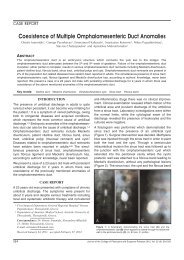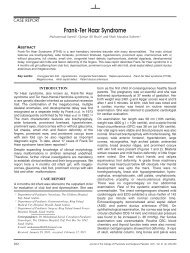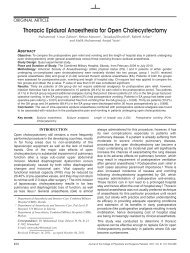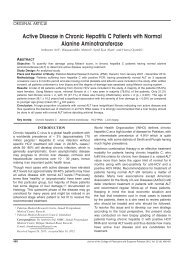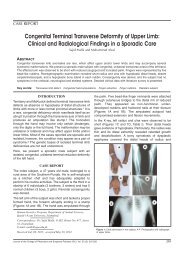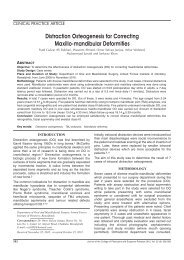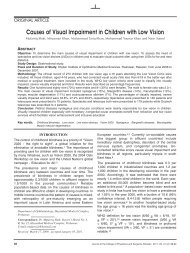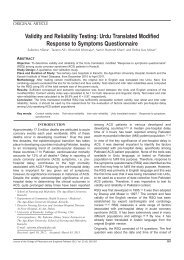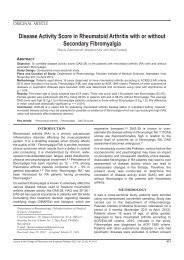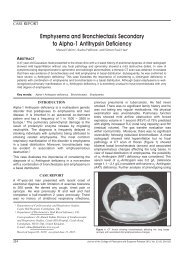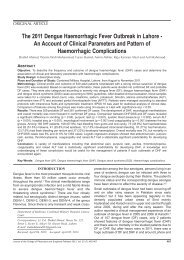Surgical Management of Femoral Artery Pseudoaneurysms ...
Surgical Management of Femoral Artery Pseudoaneurysms ...
Surgical Management of Femoral Artery Pseudoaneurysms ...
Create successful ePaper yourself
Turn your PDF publications into a flip-book with our unique Google optimized e-Paper software.
<strong>Surgical</strong> management <strong>of</strong> femoral artery pseudoaneurysms secondary to drug abuse<br />
Results were presented as mean ± standard deviation<br />
for continuous data and absolute or relative frequency<br />
for categorical data. SPSS s<strong>of</strong>tware version 13 was used.<br />
RESULTS<br />
There were 21 male patients with the mean age<br />
32.2±5.2 years (range, 20-48 years). The data <strong>of</strong> the<br />
study population are shown in Table I. Patients did not<br />
give a true history <strong>of</strong> drug abuse. It was ascertained<br />
that the predominant drug that was abused was heroin.<br />
All patients had a combination <strong>of</strong> pain and swelling in<br />
the groin. Five patients presented with significant<br />
hemorrhage (the locations were the left side in 9 cases<br />
and the right side in 12 cases). The injured artery was<br />
the common femoral artery and its bifurcation.<br />
In 14 patients (64%), ligation-excision was carried out.<br />
In 5 patients (26%), primary repair <strong>of</strong> the artery<br />
with over-sewing was done. In 2 patients (10%),<br />
revascularization with saphenous interposition was<br />
carried out. Below-knee amputation was necessary in<br />
one patient who underwent ligation-excision. One<br />
patient died due to severe septicemia.<br />
Table I: Characteristics <strong>of</strong> male patients with infected false aneurysms<br />
related to intravenous drug abuse.<br />
Variables<br />
Absolute frequency<br />
Age (years)<br />
20-30 9<br />
30-40 11<br />
40-50 1<br />
Presentation<br />
Pain 21<br />
Swelling 21<br />
Bleeding 5<br />
Surgery type<br />
E-L 14<br />
PR 5<br />
E-SI 2<br />
Amputation required 1<br />
E-L, excision <strong>of</strong> pseudoaneurysm and ligation <strong>of</strong> femoral artery; PR, primary repair with<br />
preservation <strong>of</strong> native vessels; E-SI, excision <strong>of</strong> pseudoaneurysm and saphenous vein<br />
interposition.<br />
DISCUSSION<br />
The diagnosis <strong>of</strong> an IFAP is straight forward even to the<br />
general surgeon because induration and erythema over<br />
a pulsatile mass is usually evident on initial examination.<br />
In some patients, s<strong>of</strong>t-tissue swelling makes pulsation <strong>of</strong><br />
the mass difficult. 9 Nevertheless in 25% <strong>of</strong> patients,<br />
IFAPs present with a non-pulsatile mass. A skin track is<br />
seen at the site <strong>of</strong> injection with purulent drainage. 10 The<br />
diminished or absence <strong>of</strong> peripheral pulses <strong>of</strong> arteries<br />
and gangrene in the extremities seen in traumatic<br />
injuries are not common in IFAPs. 11<br />
A history <strong>of</strong> inadvertent or intentional arterial puncture<br />
several days-to-weeks before hospital admission was<br />
reported by most <strong>of</strong> the patients, and this could have led<br />
to active bleeding. 11 Five (25%) <strong>of</strong> our patients suffered<br />
bleeding before seeking medical help.<br />
High-quality evidence on the best management <strong>of</strong><br />
infected femoral false aneurysms is lacking. Clinicians<br />
must rely on several heterogeneous case series. 7,12 The<br />
aim <strong>of</strong> treatment should be to obtain sufficient<br />
debridement and to control bleeding. 13 Any swelling<br />
around the great vessels in drug abusers should be<br />
assumed to be an IFAP unless proven otherwise. Urgent<br />
referral to a vascular surgeon for appropriate treatment<br />
should be encouraged. 1<br />
The therapeutic options that have been proposed or<br />
presented in the literature include: primary repair,<br />
immediate interposition grafting, extra-anatomic bypass,<br />
ligation-excision alone, and delayed revascularization.<br />
Some authors have employed more than one option. 14<br />
In 5 <strong>of</strong> our patients (35%), primary repair <strong>of</strong> the common<br />
femoral artery with over-sewing was carried out. Primary<br />
repair with preservation <strong>of</strong> native vessels is usually<br />
thought to be the best choice if the infection is limited.<br />
However, it is not advocated by some surgeons because<br />
extensive damage <strong>of</strong> the arterial wall causes secondary<br />
bleeding. 15<br />
In 2 patients (10%), revascularization with saphenous<br />
interposition grafting was done without complication and<br />
amputation was not required. Attempts to utilize<br />
prosthetic materials in the infected bed <strong>of</strong> resected<br />
IFAPs have yielded poor results. Tsao et al. recently<br />
reported a case <strong>of</strong> an IFAP managed with an arterial<br />
allograft hypogastric artery. 10 Georgiadis et al. reported<br />
26 patients with infected fermoral artery false aneurysm,<br />
who underwent revascularization with vein graft or vein<br />
angioplasty. In this series no claudication but two cases<br />
<strong>of</strong> bleeding were detected after surgery. 11<br />
Extra-anatomic bypass through non-infected tissue<br />
planes provides an alternative approach, but this<br />
approach was not used in our patients. 16 If successful<br />
treatment is a viable limb and resistance to re-infection,<br />
then a more rational and cosmetically pleasing choice is<br />
to lay an autogenous channel in an anatomically<br />
separate course that is not infected. 14 If an infection in<br />
the groin reaches the medial thigh, the lateral femoral<br />
route is chosen. In this way the superficial femoral artery<br />
and deep femoral artery can be revascularized. If<br />
possible, retrograde flow should be retained, and the<br />
common femoral artery ligated just proximal to the<br />
bifurcation to prevent necrosis <strong>of</strong> the thigh. Ligation<br />
alone permits communication between the pr<strong>of</strong>unda<br />
femoral artery and superficial femoral artery to be<br />
maintained. If the pelvis is free <strong>of</strong> infection, proximal<br />
anastomosis can be employed to the common or<br />
external iliac artery. If the pelvis is infected, the axillary<br />
artery or contralateral femoral vessels can be used. 11<br />
Journal <strong>of</strong> the College <strong>of</strong> Physicians and Surgeons Pakistan 2011, Vol. 21 (11): 672-675 673




